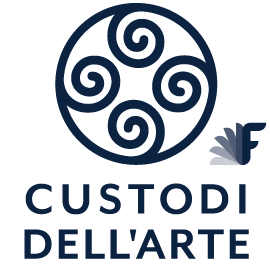

The bench in front of the fish market (on Corso Garibaldi)
The bench in front of the fish market (on Corso Garibaldi)
Riproduci traccia audio
Play audio track
Audio-Track abspielen
The bench in front of the fish market (on Corso Garibaldi)
Trascrizione traccia audio
There are so many benches along the port, but this one is special to me. From here I can see the inscription “1911” on the wall of the fish market. How many stories could that wall tell? Many, I’m sure, my story too.
If I close my eyes, I see myself as a child. It’s the early seventies and I liked to get here by walking through the fish market. I would enter through the doors on Piazza Fiorentini, pass by the fishmongers’ stalls and then exit on the port side, finding myself amongst the fruit and vegetable stalls, which used to set up here, close to the fishermen sewing their nets and right next to a well-known book shop that was run by Lorenzo and Maria.
To the right of the fish market, was my family’s Osteria.
I lived right there, on the first floor. I remember my grandfather opening at five in the morning for the fishermen returning from sea and for the farmers bringing produce to the market from the countryside. Instead of a brioche for breakfast they would eat cockerel, rabbit, and fish.
A little later the “azdore”, the dialect name for a traditional Romagnan housewife, would arrive at the market. These ladies were not just any old housewives, the Azdore reigned over their households like queens. In those days when the Romagna region, was known as “red Romagna” due to its communist inclinations, before going shopping, the Azdore would secretly drop into the monastery to say their daily prayers. In fact, in some households the men preferred their wives to go to the friars in the monastery rather than to the priests and the reason behind this lies a special local tradition. It is said that during the time of the Papal States, the Azdore were unable to obtain eggs for their daily pasta making, because the priest had taken them all for his own use. So, while kneading their dough, made from only flour and water, the Azdore hoped that the priest would choke himself on his abundance of eggs. Our most famous local pasta is called Strozzapreti, made from only flour and water into small pieces of twisted dough, and it literally means “strangled priests”.
These are the stories of old Romagna where there was also never a shortage of bell towers. From this bench, if we turn our heads a little to the right we can see Cesenatico’s Bell tower, situated straight in front of the boats with their colourful sails.
Around the fish market everything would come to life. The smells, the colours, and the sounds all intermingled with each other.
The cries of the “azdore”, the songs sung by the men of both the sea and the country who found themselves together at the Osteria, playing cards and drinking a glass of Sangiovese. Sometimes, almost always in fact, it was more than just a glass… and then they would start to tell their amazing stories, for the most part in our local dialect, but also in dialects from other parts of the country such as Chioggia or San Benedetto, both on the Adriatic coast and where many of the sailors came from.
In the summer there were that many people that there were not enough tables under the veranda. More were added next to the walls that were once covered in posters and then even further on nearer and nearer the port. It was a sight never to be seen again, so many tables, so many chairs and so many bicycles!
In winter, however, the men all holed up in the tavern. Fog outside and fog inside. The eerie sound of the foghorn outside and the cigarette smoke inside.
From early each morning my grandfather Vittorio served a white or a red wine to simple, cheerful men such as Bubuia, Tambur, Spacco, Fufi …; men of an era that no longer exist who, for their final journey were accompanied to their “cemetery at sea”, also where Marino Moretti, Cesenatico’s famous poet and author rests.
My friend Franco and Me, would talk about all these characters and others whilst we sat on this bench as kids. From here we went to buy the first American Denim jeans that arrived in the shops, we talked of Nerio and Manuvlin, the guys who delivered our gas cannisters, and old Giorgio too. Old memories from Monte, our quarter of town, the quarter where you will find the fish market and also this bench.
They were people who knew how to look you in the eye and live for the moment. With a reason to laugh and joke every day, there were no sad days.
We should never forget the world of the local town’s osterias.
Audio Track transcription
There are so many benches along the port, but this one is special to me. From here I can see the inscription “1911” on the wall of the fish market. How many stories could that wall tell? Many, I’m sure, my story too.
If I close my eyes, I see myself as a child. It’s the early seventies and I liked to get here by walking through the fish market. I would enter through the doors on Piazza Fiorentini, pass by the fishmongers’ stalls and then exit on the port side, finding myself amongst the fruit and vegetable stalls, which used to set up here, close to the fishermen sewing their nets and right next to a well-known book shop that was run by Lorenzo and Maria.
To the right of the fish market, was my family’s Osteria.
I lived right there, on the first floor. I remember my grandfather opening at five in the morning for the fishermen returning from sea and for the farmers bringing produce to the market from the countryside. Instead of a brioche for breakfast they would eat cockerel, rabbit, and fish.
A little later the “azdore”, the dialect name for a traditional Romagnan housewife, would arrive at the market. These ladies were not just any old housewives, the Azdore reigned over their households like queens. In those days when the Romagna region, was known as “red Romagna” due to its communist inclinations, before going shopping, the Azdore would secretly drop into the monastery to say their daily prayers. In fact, in some households the men preferred their wives to go to the friars in the monastery rather than to the priests and the reason behind this lies a special local tradition. It is said that during the time of the Papal States, the Azdore were unable to obtain eggs for their daily pasta making, because the priest had taken them all for his own use. So, while kneading their dough, made from only flour and water, the Azdore hoped that the priest would choke himself on his abundance of eggs. Our most famous local pasta is called Strozzapreti, made from only flour and water into small pieces of twisted dough, and it literally means “strangled priests”.
These are the stories of old Romagna where there was also never a shortage of bell towers. From this bench, if we turn our heads a little to the right we can see Cesenatico’s Bell tower, situated straight in front of the boats with their colourful sails.
Around the fish market everything would come to life. The smells, the colours, and the sounds all intermingled with each other.
The cries of the “azdore”, the songs sung by the men of both the sea and the country who found themselves together at the Osteria, playing cards and drinking a glass of Sangiovese. Sometimes, almost always in fact, it was more than just a glass… and then they would start to tell their amazing stories, for the most part in our local dialect, but also in dialects from other parts of the country such as Chioggia or San Benedetto, both on the Adriatic coast and where many of the sailors came from.
In the summer there were that many people that there were not enough tables under the veranda. More were added next to the walls that were once covered in posters and then even further on nearer and nearer the port. It was a sight never to be seen again, so many tables, so many chairs and so many bicycles!
In winter, however, the men all holed up in the tavern. Fog outside and fog inside. The eerie sound of the foghorn outside and the cigarette smoke inside.
From early each morning my grandfather Vittorio served a white or a red wine to simple, cheerful men such as Bubuia, Tambur, Spacco, Fufi …; men of an era that no longer exist who, for their final journey were accompanied to their “cemetery at sea”, also where Marino Moretti, Cesenatico’s famous poet and author rests.
My friend Franco and Me, would talk about all these characters and others whilst we sat on this bench as kids. From here we went to buy the first American Denim jeans that arrived in the shops, we talked of Nerio and Manuvlin, the guys who delivered our gas cannisters, and old Giorgio too. Old memories from Monte, our quarter of town, the quarter where you will find the fish market and also this bench.
They were people who knew how to look you in the eye and live for the moment. With a reason to laugh and joke every day, there were no sad days.
We should never forget the world of the local town’s osterias.
Audiotrack-Text
There are so many benches along the port, but this one is special to me. From here I can see the inscription “1911” on the wall of the fish market. How many stories could that wall tell? Many, I’m sure, my story too.
If I close my eyes, I see myself as a child. It’s the early seventies and I liked to get here by walking through the fish market. I would enter through the doors on Piazza Fiorentini, pass by the fishmongers’ stalls and then exit on the port side, finding myself amongst the fruit and vegetable stalls, which used to set up here, close to the fishermen sewing their nets and right next to a well-known book shop that was run by Lorenzo and Maria.
To the right of the fish market, was my family’s Osteria.
I lived right there, on the first floor. I remember my grandfather opening at five in the morning for the fishermen returning from sea and for the farmers bringing produce to the market from the countryside. Instead of a brioche for breakfast they would eat cockerel, rabbit, and fish.
A little later the “azdore”, the dialect name for a traditional Romagnan housewife, would arrive at the market. These ladies were not just any old housewives, the Azdore reigned over their households like queens. In those days when the Romagna region, was known as “red Romagna” due to its communist inclinations, before going shopping, the Azdore would secretly drop into the monastery to say their daily prayers. In fact, in some households the men preferred their wives to go to the friars in the monastery rather than to the priests and the reason behind this lies a special local tradition. It is said that during the time of the Papal States, the Azdore were unable to obtain eggs for their daily pasta making, because the priest had taken them all for his own use. So, while kneading their dough, made from only flour and water, the Azdore hoped that the priest would choke himself on his abundance of eggs. Our most famous local pasta is called Strozzapreti, made from only flour and water into small pieces of twisted dough, and it literally means “strangled priests”.
These are the stories of old Romagna where there was also never a shortage of bell towers. From this bench, if we turn our heads a little to the right we can see Cesenatico’s Bell tower, situated straight in front of the boats with their colourful sails.
Around the fish market everything would come to life. The smells, the colours, and the sounds all intermingled with each other.
The cries of the “azdore”, the songs sung by the men of both the sea and the country who found themselves together at the Osteria, playing cards and drinking a glass of Sangiovese. Sometimes, almost always in fact, it was more than just a glass… and then they would start to tell their amazing stories, for the most part in our local dialect, but also in dialects from other parts of the country such as Chioggia or San Benedetto, both on the Adriatic coast and where many of the sailors came from.
In the summer there were that many people that there were not enough tables under the veranda. More were added next to the walls that were once covered in posters and then even further on nearer and nearer the port. It was a sight never to be seen again, so many tables, so many chairs and so many bicycles!
In winter, however, the men all holed up in the tavern. Fog outside and fog inside. The eerie sound of the foghorn outside and the cigarette smoke inside.
From early each morning my grandfather Vittorio served a white or a red wine to simple, cheerful men such as Bubuia, Tambur, Spacco, Fufi …; men of an era that no longer exist who, for their final journey were accompanied to their “cemetery at sea”, also where Marino Moretti, Cesenatico’s famous poet and author rests.
My friend Franco and Me, would talk about all these characters and others whilst we sat on this bench as kids. From here we went to buy the first American Denim jeans that arrived in the shops, we talked of Nerio and Manuvlin, the guys who delivered our gas cannisters, and old Giorgio too. Old memories from Monte, our quarter of town, the quarter where you will find the fish market and also this bench.
They were people who knew how to look you in the eye and live for the moment. With a reason to laugh and joke every day, there were no sad days.
We should never forget the world of the local town’s osterias.
Narrato da
Narrated by
Mehr Infos



